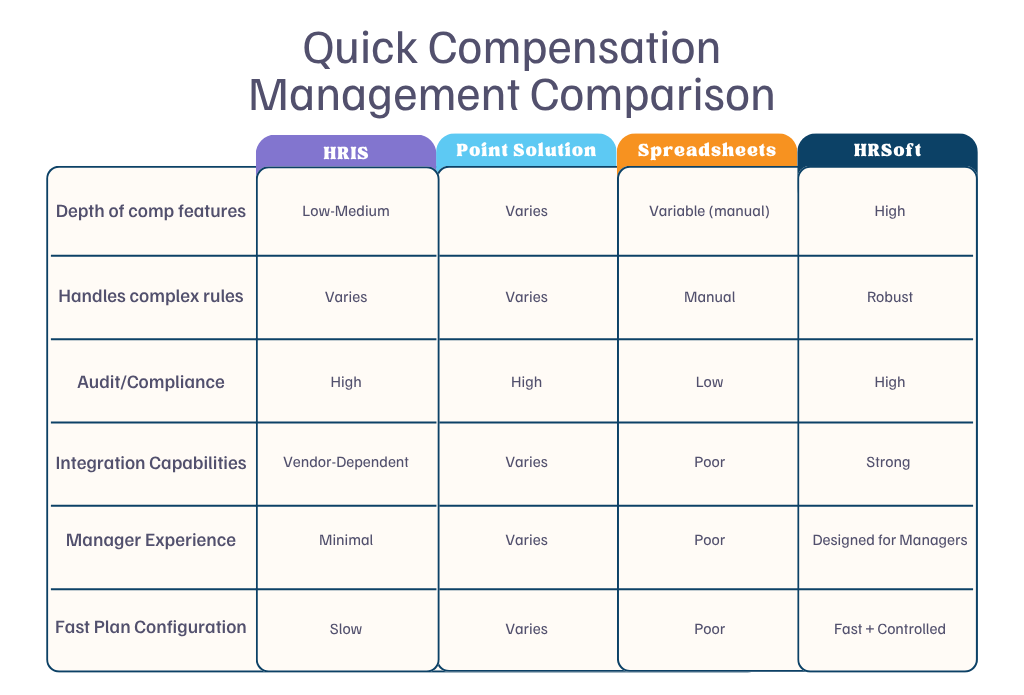Compensation at scale isn’t just math — it’s people, policy, systems, and company strategy. Below, we’ve sketched the top approaches enterprise organizations use to manage compensation programs, the strengths and weaknesses of each, and the practical situations where they make sense. At the end, there is a clear, realistic recommendation for teams deciding between an HRIS, point solution, spreadsheets, or HRSoft for their compensation management platform.
1) HRIS Platforms (Workday, SuccessFactors, UKG, etc.)
What it is: Core HR systems that include payroll, benefits, talent, and often (basic) compensation modules as part of a broad people-data platform.
Why enterprises choose them
- Single source of truth for employee records and payroll.
- Tight integration with HR transactions (hires, transfers, terminations).
- Strong security, compliance, and centralized reporting.
Limitations
- Compensation features are usually generic — fine for base salary and standard merit cycles, but weak for complex incentive plans, equity administration, or highly customized pay rules.
- Rollouts can be slow and expensive; change requests are often constrained by vendor roadmaps.
- 3rd party implementation/consultants are often used versus working with the vendor themselves.
- Less flexibility for frequent plan experiments or for localized pay practices.
Best for: Organizations that prioritize consolidation, minimal vendor overhead, and have relatively standard compensation needs.
2) Point Solutions (Best-of-Breed Compensation Tools)
What it is: Dedicated compensation platforms focused on pay planning, merit increases, bonuses, equity, modeling, and audit trails.
Why enterprises choose them
- Deep feature sets tailored to compensation: modeling, scenario planning, complex eligibility rules, manager workflows, and total rewards statements.
- Faster time-to-value for compensation-specific processes than expanding an HRIS.
- Often provide integrations (APIs, SSO) to sync employees and payroll.
Limitations
- Another system to integrate and maintain (identity, data sync, security).
- Can feel like “yet another tool” to managers unless change management is handled well.
- Vendor selection matters — capabilities vary widely across best-of-breed compensation tools.
Best for: Organizations that need sophisticated pay programs (variable pay, equity, job families, market adjustments) and want faster feature innovation than an HRIS can provide.
3) Spreadsheets (Excel / Google Sheets)
What it is: The classic — humans + spreadsheets + formulas + macros.
Why enterprises still use them
- Extremely flexible and familiar to managers.
- Low upfront cost and easy to prototype or model custom scenarios.
- Useful for small pilots or very bespoke one-off calculations.
Limitations
- Error-prone at scale: broken formulas, versioning problems, manual copy/paste risks.
- Errors = money. Check out this ROI calculator to see how much money.
- No audit trail, poor security controls, and almost zero automation.
- Difficult to consolidate across distributed teams or run enterprise-wide reporting reliably.
Best for: Quick models, short-term pilots, or hyper-custom one-off scenarios. Spreadsheets are not sustainable for recurring enterprise processes at scale.
4) HRSoft (Best-of-Breed Compensation Platform with Enterprise Focus)
What it is: HRSoft is considered one of the best compensation software solutions because it is a compensation-first platform built for the complexity of enterprise compensation programs — merit cycles, bonus programs, long-term incentives, carried interest, global pay rules, and manager workflows.
Why teams pick HRSoft
- Compensation-first design: deep pay modeling, configurable eligibility, and scenario planning built into the workflow.
- Scales across complex programs (global geographies, multiple pay components, equity, restricted budgets, and different hierarchies).
- HRSoft is a strong fit with Fortune 1000 companies or global organizations with distributed teams
- Integrates with HRIS and payroll via APIs/SSO so HRSoft becomes the compensation engine while the HRIS remains the employee data source.
- Focus on manager experience and communications: clear review interfaces, total rewards statements, and audit-ready documentation.
Designed for speed: configure new plans without a heavy engineering lift, enabling experimentation and faster cycle cadence.
Limitations to consider
- Any best-of-breed platform requires integration and governance with existing HR systems.
You’ll want to invest in change management so managers adopt the new workflows and stop relying on spreadsheets.
Best for: Enterprises that view compensation as a strategy for recruiting and retaining their employees and who want deep compensation capabilities, quicker iteration than an HRIS, and a secure, integrated solution (not another spreadsheet). Explore HRSoft’s Compensation Management solutions.

Practical Playbooks — When to Use What
- Single-system, standard pay practices: Lean on your HRIS for day-to-day payroll and base salary admin. Use the HRIS compensation module if your needs are simple and you want one vendor to manage.
- Rapidly evolving compensation programs: Use HRSoft or a point solution to iterate — then integrate outcomes back into the HRIS for payroll posting.
- One-off modeling and ideation: Use spreadsheets for explorations, then move validated models into a controlled system (HRSoft or point solution) to operationalize them.
- If security, auditability, and scale matter: Avoid spreadsheets as the system of record. Invest in an integrated compensation platform.
Top Questions to Ask Before Choosing
- How complex are our eligibility and pay rules today — and in 2–3 years?
- Do we need rapid scenario planning and what-if modeling?
- How important is manager self-service and communications?
- Can our HRIS cover our needs, or would a compensation-first engine reduce cycle time and errors?
- What integrations (HRIS, payroll, SSO) and security certifications do we require?
Bottom Line (Practical Recommendation)
Enterprises should stop treating compensation as a paperwork exercise. If your pay programs are more than standard annual merit increases, you’ll outgrow spreadsheets and HRIS compensation modules quickly.
A best-of-breed enterprise compensation platform (like HRSoft) — integrated with your HRIS and payroll — gives you the rigour, agility, and manager experience needed to run modern pay programs at scale: accurate audit trails, flexible plan configuration, fast modeling, and better employee communications.
Use spreadsheets for early-stage modeling only; use the HRIS as the employee record; and use a compensation-first tool to operate your pay programs.
Connect with us to see if HRSoft is the right fit for your team.



